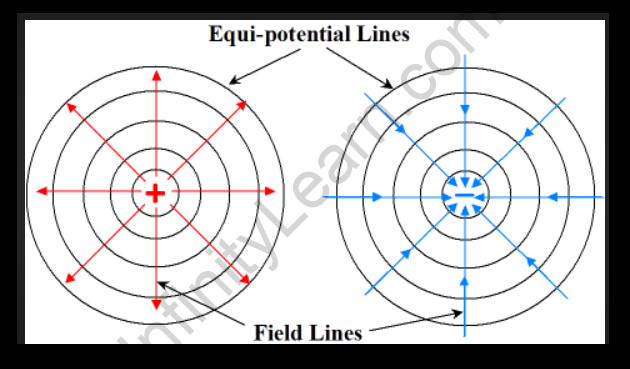Table of Contents

Introduction
In mathematics and physics, equipotential or isopotential refers to an area in space where all points have the same potential. This is most commonly used to describe a scalar potential (in which case it is a level set of the potential), but it can also be used to describe vector potentials. In n-dimensional space, the equipotential of a scalar potential function is often an (n1)dimensional space. The del operator shows how a vector field and its associated scalar potential field are related. The term ‘equipotential’ or simply ‘an equipotential’ can be used to describe an equipotential zone.
What does Surface mean?
The outermost layer of a material or substance, as defined by chemistry and physics. The physical and chemical properties of a surface differ from those of the bulk material because the particles (atoms or molecules) on the surface have nearest neighbours beside and below but not above them; hence, surface chemistry is a branch of physical chemistry. Aspects of surface behaviour include crystal formation, catalyst and detergent effects, as well as adsorption, surface tension, and capillarity. Electroplating, paint, oxidation-reduction, bleaching, and other methods are all used to improve the appearance of the surface.
Equipotential Surface Properties
1. An equipotential surface has an electric field that is constantly perpendicular to it.
2. It is impossible for two equipotential surfaces to intersect.
3. Equipotential surfaces for a point charge are concentric spherical shells.
4. Equipotential surfaces are planes normal to the x-axis given a homogeneous electric field.
5. The equipotential surface is oriented from high potential to low potential.
6. The potential inside a hollow charged spherical conductor is constant. Equipotential volume can be used to this. Moving a charge from the center to the surface requires no effort.
7. The equipotential surface of an isolated point charge is a sphere. Different equipotential surfaces exist around the point charge, i.e. concentric spheres.
8. Any plane parallel to the field direction is an equipotential surface in a homogeneous electric field.
Bonding for Pools with Equipotential Potential
Only connecting the metal elements around the pool to one another may not produce a complete equipotential plane in pools and spas. Because electricity may go through any material, more than only the metal parts must be connected together. Proper bonding necessitates a good connection, yet corrosion or improper equipment might result in poor routes to the ground.
The development of an equipotential grid is required to create a permanent, electrically safe environment surrounding swimming pools. An equipotential grid creates a zone where there is no substantial voltage differential between items that are touched at the same time.
Ladders, handrails, light fixtures, drains, and the pool water itself are examples of objects that can be touched simultaneously at a pool. An equipotential grid is made by electrically joining all of these things, linking them together so that no differences are produced.
Installed below the pool and deck, equipotential bonding grids are suitable outlets for any free electricity. Equipotential grids are designed and built with the intention of lowering electrical flow as a whole, rather than stitching together individual sections.
The builder can ensure that the pool area will fulfil the code by developing an equipotential grid before construction. Equipotential bonding grids are the most effective approach to protect families from stray voltage and ensure that they may continue to enjoy swimming and spending time together for many years to come.
What is the Equipotential Surface and how does it work?
We can draw drawings to depict electric potentials or voltages, much like we did to illustrate electric fields. This isn’t surprising, given how closely the two notions are intertwined
The following illustration depicts an isolated positive point charge and the Electric Field lines that radiate out from it, terminating on negative charges. We utilized blue arrows to depict the Electric Field’s direction and magnitude, and green lines to represent regions where the Electric Potential remains constant.
In three dimensions, these are known as Equipotential Surfaces, while in two dimensions, they are known as Equipotential Lines. Equipotential can also be used as a word to describe an Equipotential Surface or line. On an imaginary sphere of radius r enclosing the Charge, the potential for a point Charge is the same at any location. This is unquestionably correct, as the potential for a point Charge is listed below.
V=kqr
As a result, it has the same value at all points ‘r’ away from the Charge. The Electric Field lines remain perpendicular to the Equipotential lines because they point away from the Charge radially.
Also read: Equation Of Tangent To Ellipse
FAQs
Is the electric field perpendicular to the equipotential' s surface?
An equipotential surface has an electric field that is constantly perpendicular to it. Two Equipotential Surfaces cannot intersect. Concentric spherical shells are equipotential surfaces for a point charge. In the presence of a homogenous electric field, equipotential surfaces are planes normal to the x-axis.
Is it possible for two equipotential surfaces to meet?
It is impossible for two equipotential surfaces to intersect. Concentric spherical shells are equipotential surfaces for a point charge. Given a homogenous electric field, equipotential surfaces are planes normal to the x-axis. From high to low potential, the equipotential surface is orientated.
What are the benefits of having an equipotential surface?
The advantage of an equipotential surface is that each point has the same potential level. An equipotential surface, in other words, is one that has the same electrical potential at all points. If all of the points are at the same distance from each other, the sum of all of them forms a dispersed space or volume.






